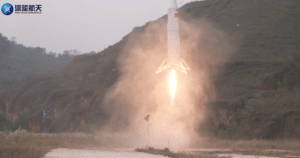by Blaine Curcio and Jean Deville
 As part of the partnership between SpaceWatch.Global and Orbital Gateway Consulting we have been granted permission to publish selected articles and texts. We are pleased to present “Dongfang Hour China Aerospace News Roundup 11 – 17 October 2021”.
As part of the partnership between SpaceWatch.Global and Orbital Gateway Consulting we have been granted permission to publish selected articles and texts. We are pleased to present “Dongfang Hour China Aerospace News Roundup 11 – 17 October 2021”.
Hello and welcome to another episode of the Dongfang Hour China Aero/Space News Roundup! A special shout-out to our friends at GoTaikonauts!, and at SpaceWatch.Global, both excellent sources of space industry news. In particular, we suggest checking out GoTaikonauts! long-form China reporting, as well as the Space Cafe series from SpaceWatch.Global. Without further ado, the news update from the week of 11 – 17 October 2021.
1) Deep Blue Aerospace Completes VTVL Test
Jean’s Take
 Deep Blue Aerospace completed a 100m-level VTVL test of its Nebula-M (星云-M) rocket on Wednesday 13 October, with this being a striking sign of the fast-paced R&D that’s going on at DBA. If you’ve been following the DFH for a while, you may remember that we reported that DBA had done a wet dress rehearsal of their Nebula-M test rocket in December 2020, a first static fire test in mid-July, followed by a meter-level hop at the end of July. And now, a 100m level hop in mid October. That’s some amazing progress in just 10 months, and also in stark contrast with the only other Chinese commercial launch company that has performed a similar feat, Linkspace, but who achieved this over a period of 4-5 years (2014-2019).
Deep Blue Aerospace completed a 100m-level VTVL test of its Nebula-M (星云-M) rocket on Wednesday 13 October, with this being a striking sign of the fast-paced R&D that’s going on at DBA. If you’ve been following the DFH for a while, you may remember that we reported that DBA had done a wet dress rehearsal of their Nebula-M test rocket in December 2020, a first static fire test in mid-July, followed by a meter-level hop at the end of July. And now, a 100m level hop in mid October. That’s some amazing progress in just 10 months, and also in stark contrast with the only other Chinese commercial launch company that has performed a similar feat, Linkspace, but who achieved this over a period of 4-5 years (2014-2019).
As a reminder, the Nebula-M is a very small, single stage rocket meant to be a VTVL demonstrator. It is equipped with a single Leiting-5 engine, which is a kerolox engine using an electrical pump to feed the propellants into the combustion chamber. This is a definite advantage for VTVL, especially on a single engine architecture, as it enables DBA to throttle the engine significantly during the landing process.
DBA will likely be performing many more such hops to gather as much data as possible to optimize the flight control systems for vertical landing. Vertical landing is a tricky thing to do, and this first 100m-level hop was a perfect illustration of that: while the test was undeniably a success, you could also observe that the landing process was not as smooth as it could have been, and more work needs to be done during the final seconds of flight to guarantee a soft touch-down.
A quick reminder of what Deep Blue Aerospace’s upcoming rocket family consists of: they are planning an expendable, kerolox, small lift rocket, able to put 500 kg into SSO, called the Nebula-1; and they are planning a reusable kerolox medium lift rocket, the Nebula-2, which will be able to put 4.5t into LEO.
Having said that, there is still a long way to go for DBA before they commercialize any of these rockets, which has not yet performed an orbital or suborbital launch, and the Leiting-5 engine used in the VTVL hop earlier this week is not the engine of the Nebula-2 reusable rocket either. For that, DBA is still developing a much heavier Leiting-20 20t kerolox engine.
All the same, DBA has demonstrated some impressive achievements over the past 12 months, and has been putting together a very solid team, including a close collaboration with China’s former chief engineer of the crewed space program Huang Chunping in August. And they are also one of the most open Chinese companies on their progress, with the publication of many videos and articles, so kudos to the company for that.
Blaine’s Take
Noteworthily, the test took place at the company’s facility in Tongchuan, Shaanxi Province, which along with neighboring Xi’an, has evolved into one of China’s leading space clusters.
To review a bit: Xi’an has long been a center of China’s launch sector, with the city earning the nickname of “The Hometown of Chinese Aerospace Propulsion” (中国航天动力之乡). As we have covered on the DFHour before, the city is home to several major CALT subsidiaries, namely AALPT and the Xi’an Aerospace Propulsion Institute. The latter was noteworthily the former employer of Zhang Xiaoping, a high-level rocket scientist who’s move to Landspace stirred controversy in one of the first examples of a commercial company hiring talent away from a major SOE. In short, this part of China has a long and storied history of leadership in rocket science, in particular for the so-called “national team”.
In more recent years, Xi’an, and neighboring Tongchuan, have both seen a robust commercial space sector develop, with particular focus on launch. In addition to the aforementioned SOEs, the area is also home to R&D centers for Deep Blue Aerospace, Landspace, S-Motor, and OneSpace, among others. Indeed, Xi’an is home to likely the second-largest concentration of rocket companies in China, behind only Beijing’s “Rocket Street”.
Xi’an and Tongchuan have also started to see a cluster of companies focused on SAR EO. This has included, Smart Satellite apparently relocating their HQ to Tongchuan, and around the same time signed an agreement with the municipal government for a SAR constellation. A final cluster around Xi’an is TT&C, with China’s main TT&C center located near Xi’an, and with the China Satellite Launch Tracking and Control Center having major operations in the area.
Many of these initiatives are clustered around the Xi’an Civil Aerospace Industrial Base, a major project that became a national 5A-level industrial base in April 2021, which noteworthily made it the country’s only national-level economic and technological development zone focused on the aerospace industry. The base is one of the country’s largest space/aerospace-focused developments, with a recent report from CGTN noting that “the industrial park has actively brought in new pilot projects to forge an aerospace industrial cluster which incorporates commercial satellite systems, rocket development, and commercial use of satellites”.
One last anecdote on the Xi’an National Aerospace Industrial Base: we saw in March 2020 the Xi’an Aerospace High-Tech Industry Development Fund raise a US$100M bond series advised by Davis Polk. This is interesting because it gives us a view of how these industrial parks are financed. This financing would ultimately, at least in part, feed through to China’s commercial space companies in the form of funding.
Separately, in Tongchuan we have seen several major space initiatives. This includes the city’s “Detailed Plan for the Aerospace City Area of the Tonghcuan High-Tech Industrial Development Zone”, as well as the “Tongchuan Commercial Aerospace Industry Development Plan”. This includes plans for a “Smart Commercial Solid Rocket Assembling Project”, with a total investment of RMB 1B.
Moving forward, we expect to see an increasing number of commercial space companies attracted to the cluster around Xi’an. The city has a lot of industrial talent, major SOEs, good universities, and increasingly, local government support. In short, probably this is not the last such launch we should expect to see from Shaanxi Province.
2) Launch of the Shenzhou-13 Crew
Jean’s Take
 The other big news of the week was the successful launch of the Shenzhou-13 crewed mission to the Chinese Space Station on the evening of Friday 15th (UTC). A Long March 2F lifted off from the Jiuquan Satellite Launch Center in Northern China, putting a Shenzhou spacecraft carrying 3 taikonauts into orbit.
The other big news of the week was the successful launch of the Shenzhou-13 crewed mission to the Chinese Space Station on the evening of Friday 15th (UTC). A Long March 2F lifted off from the Jiuquan Satellite Launch Center in Northern China, putting a Shenzhou spacecraft carrying 3 taikonauts into orbit.
The three taikonauts of the Shenzhou-13 crew were Zhai Zhigang, Wang Yaping, and Ye Guangfu, who were the back-up crew for the Shenzhou-12 mission which took place earlier this year. For two of the taikonauts, it represents the second flight:
- Zhai Zhigang, the oldest taikonaut and also the commander of the mission, was the first Chinese ever to perform a spacewalk during the Shenzhou-7 mission in 2008, and he was the person in the famous picture shot during the very first spacewalk, where you could see a taikonaut waving a Chinese flag.
- Wang Yaping, who is the first woman to board the Tianhe core module. Shenzhou 13 also represents her second flight, as she was part of the Shenzhou 10 crew in 2013. She was notably known to have performed a live broadcast of a physics lesson to Chinese lower school students.
For the third taikonaut, Ye Guangfu, this will represent a first flight. Fun fact: Ye Guangfu was the taikonaut sent to Sardaigna in 2016 to train with ESA, and also part of the 16 taikonauts that trained with 2 ESA astronauts in China in 2017. It is likely Ye Guangfu will play a role in a future ESA astronaut stay in the CSS after 2022.
Back to the Shenzhou 13, the Shenzhou spacecraft docked 6 and ½ hours after lift-off, kicking-off the six month stay of the Shenzhou-13 crew. This will represent the longest consecutive stay ever for the Chinese, breaking the record of 3 months established just one month earlier by the Shenzhou-12 mission.
So what will be some of the main missions of Zhai Zhigang, Wang Yaping and Ye Guangfu?
The Shenzhou-13 mission represents the 5th and final mission of the so-called “Critical Technology Verification” Phase, which started in March 2020 with the launch of the Tianhe-1 core module, and continued after that with the launch of 2 Tianzhou spacecraft (TZ-2 and TZ-3), and two Shenzhou missions (SZ-12 and the current SZ-13). The objective is to validate the performance of the Tianhe-1 core module from all aspects: life support systems, GNC, refueling, docking, power systems, communications, etc.
Among the tasks of the Shenzhou-13, there will be among other things:
- The validation of the Shenzhou spacecraft docking to the nadir port of the multi-docking node. And this has actually already been successfully performed during the initial docking of the Shenzhou 13 spacecraft.
- The robotic arm of the space station will also transfer the Tianzhou-2 spacecraft, currently docked to the front port, to one of the side docking ports. This is to verify the ability of the robotic arm to do this with the future Wentian and Mengtian experimental modules if necessary. Mengtian and Wentian have their own Lyappa arms to move themselves to the side docking ports, but the robotic arm needs to be able to perform this operation as a back-up if necessary.
- The remote operation of the robotic arm/manipulator (手控遥操作)
- Microgravity and space medicine experiments
- Space outreach events (likely Wang Yaping teaching?)
- 2-3 additional EVAs
- Validating that the 6-month stay went well, as this duration will become the standard for all future crew missions on the CSS.
3) Long March-2D Launch with Various Smallsats
Blaine’s Take
Thursday afternoon China time, we saw a Long March-2D launch 11 satellites, of which 8 were smallsats in a rideshare organized by CGWIC. The launch was the first time that the LM-2D had sent more than 10x satellites into orbit in a single launch. As a reminder, the LM-2D is a two-stage liquid-fueled rocket manufactured by SAST, a major subsidiary of CASC, and is capable of lifting around 1200kg to 700km SSO. This was the 55th launch of the LM-2D, and the rideshare element is but the latest example of CASC more directly targeting the commercial market. Notably, this was also the first LM-2D to include grid fins on the rocket’s first stage, a technology that is being progressively rolled out across different Chinese rockets in an effort to have better control of the landing area of the first stage.
The largest payload (and one which was not arranged by CGWIC) was China’s first solar observatory, the China H-Alpha Solar Explorer, which we discussed in some detail on the Zhuhai Air Show debrief episode a couple of weeks ago. CHASE will image parts of the sun in specific wavelengths, aiming to capture phenomena such as solar prominences. As a reminder, CHASE will be using the Hα, a deep-red spectral line at a wavelength of 656.28 nm.
The launch also included the Tianshu-1 satellite, an enhanced GNSS satellite bound for LEO and set to be operated by Chinese commercial space company FireEye Positioning (火眼位置), an enhanced navigation location-based services company founded in 2019. Notably, FireEye completed a RMB 30M series A funding round in late 2020. At the time of the funding round, the company noted plans to launch a test satellite by mid-2021, indicating a small delay.
Shenzhen Dongfanghong, a CASC subsidiary focused on satellite manufacturing, had two of its satellites launched for different customers. The first is the interestingly named “Commercial Meteorological Observation Constellation Test Satellite”, which will use, among other things, signals from navigation satellites to measure atmospheric conditions, with apparent potential for commercial applications. The second satellite was the low earth orbit atmospheric density detection test satellite, which aims to carry out verification for obtaining LEO atmospheric density and composition parameters.
Other payloads included 2x satellites for HEAD Aerospace, both of which are primarily Earth Observation with some location-based services element, as well as a couple of satellites for APSCO, one of which was done in partnership with MinoSpace. The launch also included a test satellite for HKATG, which was interestingly launched by the company’s apparent Shenzhen subsidiary, 港航科(深圳)空间技术有限公司.
Finally, Satellite Herd announced that they had provided TT&C services for 6 of the satellites, including the 2x HEAD Aerospace satellites, Beihang SSS-1, the Shenzhen Dongfanghong Orbit Atmospheric Density Detection satellite, QX-1, and VDES.
Overall, the launch comes at an interesting time. A few weeks ago at the Zhuhai Air Show, we saw no less than 5 commercial satellite manufacturers book launches with CGWIC, several of which were for rideshare launches on the LM-8 or LM-2D. As we saw in this launch, there were a wide variety of commercial space companies hitching a ride on the LM-2D, on a mission led by a big, but not enormous anchor client (CHASE satellite again being around 500kg, or ~35-40% of the rocket’s capacity to SSO).
When looking back at the evolution of the Chinese commercial space sector sometime in the future, I believe that these few weeks, with the Zhuhai Air Show announcements, this launch, and several more launches before the end of the year, will mark the real beginning of the operational phase of the Chinese commercial space ecosystem, and at a minimum, should mark a turning point for rideshare.
This has been another episode of the Dongfang Hour China Space News Roundup. If you’ve made it this far, we thank you for your kind attention, and look forward to seeing you next time! Until then, don’t forget to follow us on YouTube, Twitter, or LinkedIn, or your local podcast source.
Blaine Curcio has spent the past 10 years at the intersection of China and the space sector. Blaine has spent most of the past decade in China, including Hong Kong, Shenzhen, and Beijing, working as a consultant and analyst covering the space/satcom sector for companies including Euroconsult and Orbital Gateway Consulting. When not talking about China space, Blaine can be found reading about economics/finance, exploring cities, and taking photos.
Jean Deville is a graduate from ISAE, where he studied aerospace engineering and specialized in fluid dynamics. A long-time aerospace enthusiast and China watcher, Jean was previously based in Toulouse and Shenzhen, and is currently working in the aviation industry between Paris and Shanghai. He also writes on a regular basis in the China Aerospace Blog. Hobbies include hiking, astrophotography, plane spotting, as well as a soft spot for Hakka food and (some) Ningxia wines.
 SpaceWatch.Global An independent perspective on space
SpaceWatch.Global An independent perspective on space




